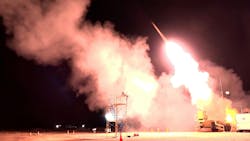Lockheed Martin to build more interceptor rockets with infrared seekers for hypersonic missile defense
Summary points:
- Lockheed Martin will build Terminal High Altitude Area Defense (THAAD) interceptors to counter incoming enemy ballistic missiles.
- Recent THAAD enhancements include hypersonic tracking radar, AI-driven targeting, interoperability with Patriot systems, and development of the extended-range THAAD-ER variant.
- THAAD combines a BAE Systems infrared seeker and the RTX Raytheon AN/TPY-2 radar to guide interceptors to their targets at altitudes as high as 93 miles.
HUNTSVILLE, Ala. – Missile defense experts at Lockheed Martin Corp. will build missile defense rocket interceptors to protect against incoming ballistic missiles under terms of a $2.1 billion order announced Monday.
Officials of the U.S. Missile Defense Agency (MDA) in Huntsville, Ala., are asking the Lockheed Martin Missiles and Fire Control segment in Dallas to build Terminal High Altitude Area Defense (THAAD) interceptors.
THAAD is designed to shoot down short-, medium-, and intermediate-range ballistic missiles in their terminal phases using a hit-to-kill kinetic warhead. The THAAD interceptor missile relies on the kinetic energy of the impact to destroy the incoming missile.
THAAD consists of five major components: launchers, interceptors, a radar, THAAD fire control and communications (TFCC) units, and THAAD support equipment.
Infrared seeker
The THAAD interceptor uses a gimbaled infrared seeker head from BAE Systems that seeks and locks onto incoming ballistic missiles traveling as fast as 17,000 miles per hour. This infrared seeker works together with the AN/TPY-2 ground-based X-band radar to guide the interceptor to the target by tracking the heat signature of the incoming ballistic missile.
The THAAD AN/TPY-2 X-band ground-based radar from RTX Raytheon is separate from the interceptor missile, and performs long-range detection, tracking, and discrimination to provide cueing and targeting data to the interceptor missile's infrared seeker for terminal guidance.
The overall guidance system integrates these sensors with real-time targeting and control to enable missile to intercept the threat after the initial detection and tracking by radar and command control units. THAAD's sensors and guidance electronics are improved continually to enhance performance against increasingly sophisticated missile threats, including hypersonic missiles.
Several notable upgrades have been made to THAAD over the past five years that involve a hypersonic missile tracking radar upgrade; interoperability enhancements; THAAD-ER extended-range development; production and deployment expansion; and THAAD System Build 6.0 software and system modernization.
Tell me more about the BAE Systems THAAD infrared seeker.
- The THAAD indium-antimonide imaging infrared seeker use advanced precision-guided missile sensing and small-form-factor electronics to improve threat discrimination, manufacturability, and adaptability to evolving ballistic missile threats -- including those with hypersonic trajectories. The seeker uses passive infrared imaging to track the plumes of incoming ballistic missiles. Once it detects a target, the seeker provides live imagery to guide the interceptor in flight and refine its trajectory.
Raytheon has provide an upgraded AN/TPY-2 radar using gallium nitride semiconductors to extend the missile's range, precisely discriminate targets, and enhanced protection against electronic attacks. It helps detect and attack maneuverable hypersonic missiles with low radar cross-sections.
THAAD also has enhanced its interoperability with the Patriot PAC-3 missiles with remote THAAD launchers, Patriot launches triggered by THAAD sensors, and improved operations together with PAC-3 interceptors.
Lockheed Martin developed the extended-range THAAD-ER with extended operational altitude and range that could triple its current engagement ceiling to higher than 180 miles. This variant has a larger booster and improved interception velocity. If funded, this variant could enter service later this decade.
Hypersonic missile defense
THAAD also is moving toward an upgrade to double detection range; add artificial intelligence ( AI) and machine learning for predictive targeting; and improved ability to counter maneuvering hypersonic missiles. Future plans include integrating space-based sensors and possibly directed-energy weapons.
Lockheed Martin started developing the THAAD system in 1992, and first tested the system three years later. The first THAAD tests that hit their targets were in 1999, after the first six ballistic missile defense tests missed. THAAD missiles, which have a maximum range of about 125 miles, are expected to hit incoming ballistic missile warheads as high as 93 miles above the Earth's surface.
On Monday's order Lockheed Martin will do the work in Dallas; Sunnyvale, Calif.; Troy, Ala.; and Camden, Ark., and should be finished by December 2029. For more information contact Lockheed Martin Missiles and Fire Control online at www.lockheedmartin.com/en-us/who-we-are/business-areas/missiles-and-fire-control.html, or the Missile Defense Agency at www.mda.mil/system/thaad.html.
About the Author
John Keller
Editor-in-Chief
John Keller is the Editor-in-Chief, Military & Aerospace Electronics Magazine--provides extensive coverage and analysis of enabling electronics and optoelectronic technologies in military, space and commercial aviation applications. John has been a member of the Military & Aerospace Electronics staff since 1989 and chief editor since 1995.

